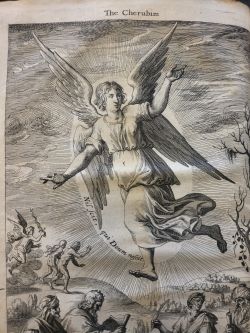The hierarchie of the blessed angells: their names, order and offices: the fall of Lucifer with his angels: Difference between revisions
(→Books) |
|||
| Line 50: | Line 50: | ||
== Construction == | == Construction == | ||
The book comes in brown leather binding, with five raised bands, and a broken spine. The cover, which is a board wrapped in leather, comes off completely. | |||
== Use == | == Use == | ||
The copy at the University of Pennsylvania has been excessively written, nearly all in what appears to be pencil, including text on the marginalia, between lines of text, and on pieces of paper that have either been attached or are loose –– the latter of these appears to have been written in pen. This book was probably studied very rigorously. | |||
<gallery> | <gallery> | ||
Revision as of 22:12, 3 May 2023

The hierarchie of the blessed angells: their names, order and offices: the fall of Lucifer with his angells is a 1635 didactic poem in nine books, a complete copy of which is at the University of Pennsylvania's Kislak Center for Special Collections, Rare Books and Manuscripts. The contents, as per the name, of the collection are concerned with the categorization of angels, or angelology, in the Christian sense, as well as the rebellion of Satan and his subsequent fall of grace, along with his demons. The author is named to be Thomas Heywood, while the printer is referred to as Adam Islip. It was printed in London and dedicated to the queen at the time: Queen Henretta Maria.
History & Content
Authorship
Thomas Heywood was a early 17th century playwright, better known for his dramatic work. His later plays, however, were criticized for being too mean and taking too much from the ancients, such as Homer.[1] Little is known of Heywood's motivations for composing this 9-book didactic poem, but a dedication following the title page expresses that the collection was composed for Queen Henretta Maria, a Roman Catholic, which made her unpopular in England and prevented her from ever being crowned[2]. Given Heywood's lack of other didactic poetry, it's possible this was a commission someone may have paid him for. Noticeably, The hierarchie of the blessed angells: their names, order and offices: the fall of Lucifer with his angells appears to be his only entirely theological work.

Angelology
Heywood used Dionysian theory as the framework from which he'd give his own interpretation of angels [3]. Additionally, he used the Ptolemaic system as the rule by which to connect the angel hierarchies to the system of the world; according to it, the universe hung by a golden chain from the Throne of God, with the universe itself being spheres within spheres until it reached the smallest one –– Earth [3]. Heywood also follows St. Augustine by implying the polytheistic gods of other and their pre-Christianization past as not senseless idols, but demons tricking humans to worship them. It's remarked that at first sight of an angel, a man will first be afraid, but an angel will reassure him. A demon, on the other hand, will first make a flattering appearance, then leave the man having terrified him.
Books
- The Seraphim
- The Cherubim

- The Dominations
- The Domination govern Jupiter, and their leader is Zadkiel.
- The Virtues
- The Virtues govern Mars, and their leader is Haniel.
- The Powers
- The Powers govern the Sun, and their leader is Raphael.
- The Principats
- The principats govern Venus, and their leader is Camael.
- The Arch-Angells
- The arch-angels govern Mercury, and their leader is Michael.

- The Angell
- The angels govern the Earth, and their leader is Gabriel.
Materiality
Construction
The book comes in brown leather binding, with five raised bands, and a broken spine. The cover, which is a board wrapped in leather, comes off completely.
Use
The copy at the University of Pennsylvania has been excessively written, nearly all in what appears to be pencil, including text on the marginalia, between lines of text, and on pieces of paper that have either been attached or are loose –– the latter of these appears to have been written in pen. This book was probably studied very rigorously.
-
Extensive writing on pages
-
Attached pages
-
Taped piece
-
Example writing
-
Loose piece
Notes
- ↑ Wright, Louis B. “Notes on Thomas Heywood’s Later Reputation.” The Review of English Studies 4, no. 14 (1928): 135–44. http://www.jstor.org/stable/508142
- ↑ https://www.englishmonarchs.co.uk/stuart_16.html.
- ↑ 3.0 3.1 Briggs, K. M. “Heywood’s Hierarchie of the Blessed Angells.” Folklore 80, no. 2 (1969): 89–106. http://www.jstor.org/stable/1258462.